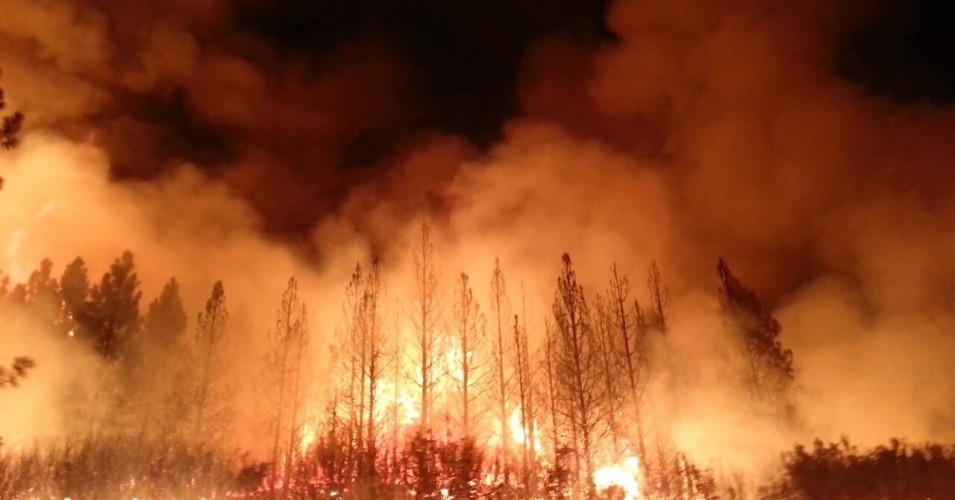“The world’s weather is becoming more extreme before our eyes—the only thing that can stop this destructive trend from escalating is a rapid fall in carbon emissions.”
By Jessica Corbett, staff writer for Common Dreams. Published 12-28-2018

The Camp and Woolsey fires in California cost at least $9-13 billion in damage, according to a Christian Aid report published Thursday. (Photo: U.S. Forest Service)
From heat waves and hurricanes to fires and floods, the 10 costliest extreme weather events of 2018—driven by the global climate crisis—killed thousands of people and caused at least $84.8 billion in damage, according to a new analysis from Christian Aid.
Counting the Cost: A Year of Climate Breakdown(pdf), published Thursday by the London-based group, notes that “extreme weather hit every populated continent in 2018, killing, injuring, and displacing millions, and causing major economic damage.”
“All of these disasters are linked with human-caused climate change,” it points out. “This report highlights some of the disastrous consequences of this warming that are already striking.”
Christian Aid’s global climate lead, Kat Kramer, said in a statement that “climate change is something still often talked about as a future problem, not least because we know the consequences of the warming climate are so devastating and don’t want to face up to what is already happening.” But, he added, as the report clearly shows, “for many people, climate change is having devastating impacts on their lives and livelihoods right now.”
Though some figures “are likely to be underestimates” due to data limitations, the report lists the following as the 10 costliest extreme weather events from 2018, the fourth-hottest year on record:
| Event | Estimated Cost (USD) |
| U.S. – Hurricanes Florence & Michael | $32 billion |
| California, U.S. – Camp & Woolsey fires | $9-13 billion |
| Europe – drought | $7.5 billion |
| Japan – floods | $9.3-12.5 billion |
| Argentina – drought | $6 billion |
| China – floods | $9.3 billion |
| Australia – drought | $5.8-9 billion |
| Kerala, India – floods | $3.7 billion |
| Cape Town, South Africa – drought | $1.2 billion |
| Philippines & China – Typhoon Mangkhut | $1-2 billion |
“The impacts of climate change are no longer subtle. We are seeing them play out now, on our television screens, newspaper headlines, and social media feeds,” responded renowned Penn State climate scientist Michael Mann. “The world’s weather is becoming more extreme before our eyes—the only thing that can stop this destructive trend from escalating is a rapid fall in carbon emissions.”
Although the COP24 summit held earlier this month in Katowice, Poland led to the development of a rulebook for the Paris climate accord—an agreement backed by every nation on Earth except the United States under the Trump administration—as studies continue to show the consequences of anthropogenic global warming, including more frequent and powerful extreme weather events, experts emphasize that the international community must be even more ambitious to prevent climate catastrophe.
As the Christian Aid report warns, “Current plans for controlling emissions put the world on course for catastrophic warming by the end of the century, with the planet heating three to five times as much as it has already,” meaning that “the fires, storms, heat waves, floods, and droughts of 2018 would seem insignificant in comparison, with the poorest and most vulnerable communities across the world at the forefront of these disasters.”
“Unless governments worldwide increase their ambition and work to cut emissions, the world will fail to prevent this disaster,” it continues, calling on every nation to “take their fair share of that global action with wealthier countries supporting the global shift to net-zero emissions through finance and technology, so that less developed countries come out of poverty in a low-carbon and sustainable way.”
“History will judge us on how we act now, as there is still a window of opportunity to avert more suffering,” Kramer concluded. “We must respond to the warning these disasters are giving us and avert more and worse ones, by accelerating the transition to a zero carbon economy: one run on clean, renewable energy that will deliver a safer climate for everyone.”
Editors’ note: Reporting on environmental issues has become one of the most hazardous beats in journalism.
This work is licensed under a Creative Commons Attribution-Share Alike 3.0 License

